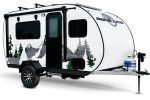All-Weather RVs
Four Season RV-ing
What makes a 4-Seasons RV the true All-Weather unit suitable for comfortable RV-ing in weather ranging from hot summer, through rainy days to icy winter....
As the concept of recreation “extended” well beyond the boundaries of traditional summer vacations, “All-Seasons” RVs became more and more popular.
Unfortunately, the RV industry is not regulated so well as the automotive one, so the definition and meaning of All-Season (4-Seasons) RV is quite vague and largely left to the manufacturers. As the result, on the market there are plenty of RVs promoted as 4-seasons units but besides higher price and weight nothing else is really obvious.
In this presentation, we would like to discuss basic elements of what makes a given RV the true All-Seasons unit.
Before we go farther first let’s decide what really means All-Season RV-ing. There will be big difference in terms of requirements (and price) if you want to:
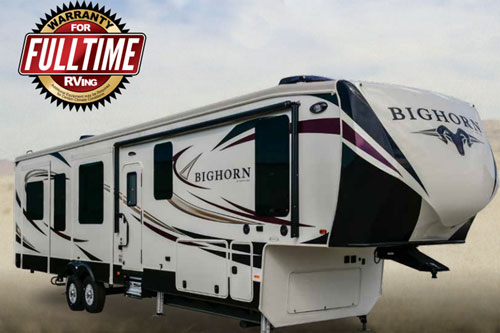
Bighorn 5th wheel - an example of an RV designed for full-time living
- Enjoy 4 seasons RV-ing in southern states where the most of what you can face in winter is just the chilly weather and real problems are rather caused by hot and humid summers;
- Extend your recreational season from early spring till late autumn in climate zones where occasionally temperatures may drop to the freezing range;
- Enjoy RV-ing in “northern” winter conditions where temperatures can go down well below the freezing point.
In southern and moderate climate-zone conditions it may be relatively easy (and certainly not too costly) to enjoy all-year RV-ing. The real challenge brings the subarctic climate zone covering US northern states and across the border large swaths of Canadian provinces (not even mentioning “Big North” - Canadian Northern territories and Alaska). That is why some prefer to call RVs designed for year-long use as “All-Weather” units. This name really reflects RV’s ability to withstand harsh weather conditions ranging from hot and humid summers, through rainy periods to cold, windy winters.
Some will also differentiate the meaning of “All-Season” RV from the point of view of length of the trip arguing that short trips do not require as much of cold weather protection as long ones (including “Full-Time Living”). Well, I would say that the main difference is rather the level of comfort (or lack of it). Because once the temperature goes permanently below the freezing point what matters the most is:
Will your RV (water pipes, tanks and drains) survive winter’s attack? (and your pocket the cost of repairs)
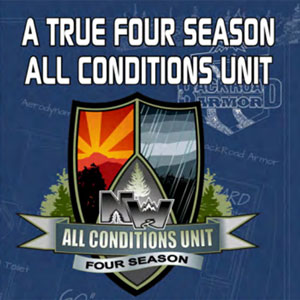
Northwood Arctic Fox label shows what really makes a True 4-Season RV: It is ability to offer RV-ing comfort in All-weather conditions including hot summer (Sun), Rainy days and cold Winter
However, what really makes the difference in terms of “All-Weather” requirements is the camping environment. Understandably, Off-Road and Off-Grid conditions make the RV-ing much more demanding even in moderate climate zones. Needless to say, that the extreme weather conditions (arctic climate in winter and “subtropical” for summer) will substantially rise the requirements to be met and cost of all-weather RVs.
The most important factors defining RV’s all-weather readiness are:
- Body construction (thermal insulation, windows, underbelly …)
- Water freezing protection (water lines, holding tanks, drain valves ..)
- Efficient climate control (heating, cooling, venting, condensation…)
- Rain protection
Before we start, let’s make it clear – there is no perfect All-Weather RV available on the market. And it’s not only due to the fact that “perfection” cannot be achieved at the “reasonable” cost, but also because so far there are no clear criteria defining the set of “all-weather” parameters and corresponding requirements. That is why for enthusiasts of all-year RV-ing we suggest taking practical approach of looking for and RV just “good enough” that will meet their individual needs. This approach will safe tons of frustration, time and definitely a lot of money.
Below you will find important elements of the “All-Weather” RV design so you will be able to make an educated decision when it comes to your “all-seasons home-away-from-home”.
RV Body Construction
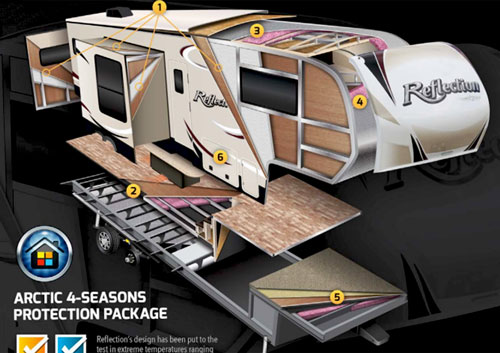
Refection (Grand Design RV) and crucial elements of its Arctic 4-seasons package:
- Fully laminated walls
- Double insulated floor
- Double insulated roof
- Double insulated front-cap
- Insulated Gooseneck (5th wheel)
- Heavy-Duty (1.5") insulated baggage doors
Chassis:
Ideally, the chassis of all-weather RVs should be corrosion resistant. Thanks to popularity of lightweight designs many contemporary mid-range models have aluminum chassis what makes them perfect candidates for year-long RV-ing. However most larger rigs due to increased load are still built on stronger, but corrosion-prone steel chassis. Typically, they are corrosion protected (usually powder-coated) what under normal circumstances should guarantee long-lasting rust-free operation. Winter changes this picture due to massive use of salt on northern states roads (so-called Salt-Belt states) and in most Canadian provinces.
It is then suggested to carefully wash RV’s underbelly after winter season to remove layers of accumulated salt. Otherwise, at higher temperatures the salt in contact with rain water and/or humidity in the air will start accelerated corrosion process. Keeping the RV in the heated garage will also have devastating effect when salt is not washed out. Note that off-road RVs exposed to gravel and debris may require periodic inspections of the underbelly and eventually additional protective coating to prevent corrosion.
Frame:
Overwhelming majority of modern recreational vehicles have wooden or aluminum frames or are frameless (all-fiberglass shells).
Not surprisingly, for long the wooden frames were the most popular and familiar solutions. Indeed, the wood is not only inexpensive but also well-known for its good thermal insulation properties essential in extreme climate zones. Unfortunately, wood is also prone to rot, mold and with it to accelerated degradation severely limiting RV’s lifespan. Unlike our residential houses, RVs are exposed to shocks and vibrations stressing hermicity of the shell.
This creates an “opening” for mentioned wood degradations. Due to much more limited interior space the humidity generated in bath, kitchen and even by our breaths in contact with colder layers of the box structure (shell) will cause water condensation. Additionally, the rain and melting snow from the outside will add to the “misery”. As the result, the wooden-frame RVs (including roof and floor structure) are not the best all-weather candidates. Their longevity will be seriously challenged!
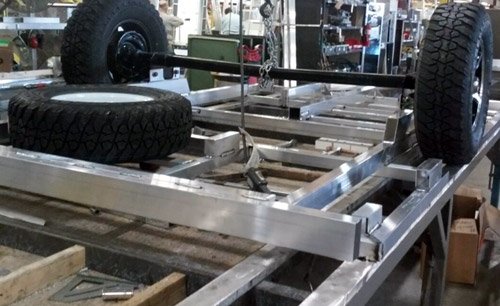
LivinLite aluminum chassis proves that it is possible (unfortunately LivinLite does not make all-weather RVs)
Modern aluminum frames are not only much lighter (being “lite” has additional advantages) but also resistant to rot and mold induced decay. However, in difference to wood, metals are good conductors of heat. In other words, the aluminum frame creates “thermal bridges” in the structure of the shell. This in turn weakens the efficiency (overall R-factor) of the thermal barrier. All-in-all, the long lifespan of aluminum-frame shells makes them the solution of choice for all-weather RVs.
In All-Fiberglass RVs, half-shells (upper and bottom) are made in the molding process and then both are “glued” together in the final step. The final result is a “self-supporting” (frameless) shell with high level of integrity (hermicity) and good thermal properties. Theoretically such shell should be preferred solution for all-weather RVs. Unfortunately, it is not the case for the following reasons:
- Despite good properties of the fiberglass (strength, good thermal parameters, waterproofness, corrosion, rot and mold resistance…) as well as seamlessness of the molding process, all-fiberglass shells are not thick enough to guarantee required overall R-value of up to 30-40 (as it may be required for roof).
- All-fiberglass RVs have “physical” limitations – the size. Most of them belong to the class of small and medium RVs. For many, limited camper’s size may be the crucial factor when selecting the all-weather RV.
- The traditional molded-fiberglass shell can easily and seamlessly integrate some basic furniture (cabinets, bed frame, shelves, storages…), however it does not integrate well the plumbing, holding tanks etc… For example holding tanks are usually placed under the shell with some mechanical protection, but are not protected from the weather (low temperatures).
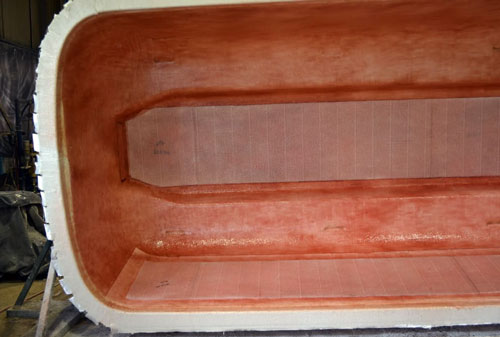
Oliver Trailers - one of the molded-fiberglass "half-shells" at the early stage of the production
While the popular "Ollie" is not the all-weather camper you may be interested to see this innovative design: --> All fiberglass Oliver Trailers
On the positive side, we can see already attempts to improve at least some of weak spots of all-fiberglass RVs. For example, some companies (Lil-Snoozy) in order to improve the overall R-value of the shell, insert during the molding process extra sheets of insulation between the layers of fiberglass. This is already a big improvement of the all-fiberglass technology.
Much more promising all-weather approach was undertaken by Oliver Trailers. The company makes their trailers from two molded fiberglass shells: inner and outer (each one made up from two half-shells). This design opens new possibilities, like insertion of adequate insulation in-between inner and outer shells and as a “side-effect” – hiding most of wiring and plumbing between shells. As the result, to overall R-value of the insulation can achieve required levels at critical locations (roof, walls, floor) and water pipes can get much needed protection. Additionally, the design (molding process) can be easily modified to allow for installation of holding tanks and draining valves in an enclosed, insulated and heated underbelly.…. (to be seen)
Thermal Insulation:
Insulation barrier is the most important factor determining the cost (heating or cooling) and comfort of RV-ing. As mentioned earlier, there are no commonly accepted standards determining minimum R-values of insulation for all-weather RV. Basically each manufacturer (Keystone, Northwood, Heartland, Lance….) comes up with its own ideas, designs and specifications.
Based on currently available models of all-weather RVs you can expect the following:
- Roof: R-30 to R-40
Roof is the most important insulation barrier. In the winter, the hot (warm) air due to natural convection accumulates at the ceiling so this is the place of highest gradient between interior and exterior temperatures. Similarly, during the summer, roof exposed to sun is the hottest spot in the RV so once again it is the area of highest gradient between exterior and interior temperatures. As the result, the roof should have the best insulation (highest R-value) throughout the box. Practically you may find roof’s “equivalent” R-values of up to 38.
- Sidewalls: R-11 and up
It should be noted that side walls may be heavily exposed to the sun (hot summer) and cold winds (winter). While opened awning and in general shade may greatly limit the impact of direct sun exposure, nothing can protect the box from “arctic” winds. That is why higher R-values of insulation in sidewalls are welcomed. Practically, sidewalls are the weakest part of RV’s insulation barrier due to windows (see below).
- Main Floor: R-20 to R-30
Good insulation of the main floor has huge impact on our comfort especially at low temperatures (after all we walk on and live in close contact with the floor). In general, the insulation of the floor in all-weather RVs is “combined” with the insulation of the underbelly where all critical water systems (pipes, valves and holding tanks) are located.
Good news is that we can easily improve the overall “underbelly and floor” protection by installing skirts along the RV. Skirts efficiently protect this vital area from freezing winds (keep in mind that the floor is sitting on the massive frame (steel or aluminum) – both very good heat conductors).
- Slide-outs: Floor R-15-to R-25, walls R-11 and up
Slide-outs are also “weak” spots in RV’s overall thermal protection. Sticking out from the main structure they are largely exposed to weather elements (be it scorching sun, arctic winds or rain….).
- Front Cap: R-20 to R-40
Front caps usually have better thermal protection than sidewalls. It is mainly to prevent the interior from freezing when on the road. High speed towing on highways creates strong headwinds that on longer trips can dramatically lower RV’s temperature. Please note that this is the most vulnerable situation for an RV (trailer, 5th-wheel, truck camper etc..), because usually the heating is turned off. While you can bring the temperature up once on the campground, it may be too late for all water installations and holding tanks.
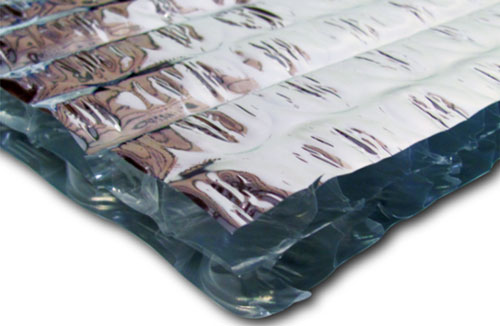
An example of the "Radiant Barrier" - here Astro Shield reflective insulation (thin-film metal layer over the thick bubble substrate)
We can dispute these values, but on the other side we have to accept the reality unless you want to DIY (not suggested in the case of thermal insulation as any such work will destroy the integrity of the box’s structure).
What is undisputable however is the type of insulation used by manufacturers. The familiar to most of us residential insulation (fiberglass-wool mat) can be used ONLY in horizontal sections of the RV (roof and floor). Rigid foam-blocks should be used in all vertical sections (walls, front cap…). This is due to the possibility of the sagging effect caused by shocks and vibrations that an RV is exposed to during its lifetime. In other words, the residential insulation may “migrate” down the wall leaving empty spaces behind. You may not notice this degradation during the traditional vacation season, but certainly you will feel the difference (energy bills and lack of comfort) in extreme weather conditions (hot summer of cold winter).
Note: Any insulation barrier acts as a “High Resistance” heat conductor (insulator) or as a “reflective” barrier. The R-value physically describes the “heat resistance” of an insulator. Higher Heat Resistance, higher R-value and better ability to “maintain” interior temperature (either low when cooling and hot when heating). In other words, more difficult for hot air to penetrate RV’s interior from the outside (summer) or to escape from the RV outside (winter).
You will notice however that these days manufacturers often make use of “Reflective” insulation barriers. They are characterized by an “equivalent” R-value as they do not transfer the heat (so do not have a true “Thermal Resistance”) but rather reflect the heat back to the area where it comes from. In practice, it is a sort of shiny metalized reflective film deposited on the polyethylene “bubble” substrate acting as the carrier and barrier for the heat transfer (conduction). Some of the reflective insulation products used in RV industry are AstroShield and Astro Eco.
To continue the overview of Construction Requirements for an All-weather RV select: --> NEXT
See also --> Best winter Travel Trailers
.


